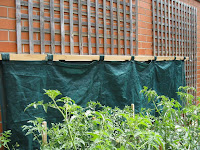It's late December and it's all happening in and out of the garden. All of our plants are producing, with new secrets to discover every time we arrive home from work. On the flipside, the ambitious growth of our patch seems to be causing me a few problems.

Black Russian Tomato
Lebanese Cucumber

Italian Capsicum - The case of the brown bum capsicum seems to be happening alot. The bottom seems to rot, rather than burn. I thought this only happened with tomatoes? (Blossom end rot)

Lazy Housewife Bean

Black Beauty Zucchini - These just grow and grow and grow. We've had about 7 now. When will they stop? My guess is 15.

Delicata Mini Sweet Pumpkin
Okay, so now the success stories out the way... to my tomatoes. This year (my only year to date) I have been raising Tommy Toes, Black Russians, and Wapsipinicon Peaches (WPs). The WPs are winning the taste test. The Tommy Toes are everywhere. The Black Russians need to hurry the hell up already.
I've done very little in terms of maintenance. Some websites advise to pinch out side shoots and growth at the top of the plant once the optimum size is reached. As this was my first year in the garden, I decided to just let them grow and see what happens. The first approach should always be the lazy approach in my book. Needless to say, they've reached a size where the stake no longer supports the growth. As such, most of the plants' new growth is at ground level, and spilling over the side of the patch.

This picture shows the new growth on the Black Russian tomato plant - plenty of flowers and nice and green (photo was taken in 37 degrees).
Despite the growth, my plants are dying a slow death. Every one of my six tomato plants seems to be dying from the bottom up. It's quite sad to watch. My rational explanation is that the plant is simply shedding unneeded leaves to channel energy to the existing fruit. The thick canopy may also be shielding light and subsequently having a negative impact at the base of the plant. But I'm losing a hell of a lot of leaves.

This is the base of the WPs. Not the worst example, but you get the picture. I've been deadheading the plants, but it's tough to keep up.

I don't have a solution to the problem. I'm just going to watch it closely for the time being. Next year though, I'll try to manage the size of my tomato plants more effectively to ensure that the plants have plenty of ventilation and support.





















